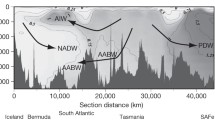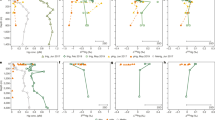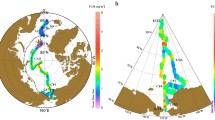Abstract
Here we report measurements of total Hg (HgT), reactive Hg (HgR), and methylmercury (MMHg) in precipitation from the equatorial Pacific Ocean, collected during a cruise in January and February 1990, and from a mid-continental location in the rural temperate lacustrine northcentral Wisconsin environs. The concentrations of HgT (14.4±6.5 pM), HgR (8.9±4.5 pM) and MMHg (<50 fM) found in equatorial Pacific rain were less than the average concentrations found in Wisconsin. In general, the results indicate that although particulate Hg is a small fraction of the total atmospheric Hg burden, it is the major contributor to Hg in precipitation. Furthermore, deposition could be an important source of HgR to the equatorial Pacific Ocean. In contrast, deposition is not a significant source of MMHg to either the equatorial Pacific Ocean or the remote seepage lakes of Wisconsin. This implies that methylated mercury is formedin situ in these systems.
Similar content being viewed by others
References
Arimoto R., Duce R.A. and Ray B.J. (1989). concentrations, Sources and Air-Sea Exchange of Trace Elements in the Atmosphere over the Pacific Ocean. InChemical Oceanography Vol. 10, Riley J.P. and Chester R. (Eds.), Academic Press, London pp. 107–151.
Bloom N.S. (1989). Determination of picogram levels of methylmercury by aqueous phase ethylation, followed by cryogenic gas chromatography with atomic fluorescence detection.Can. J. Fish. Aquat. Sci. 46 1131–1140.
Bloom N.S. and Watras C.J. (1989). Observations of methylmercury in precipitation.Science of the Total Environment 87/88 199–207.
Bloom N.S. and Fitzgerald W.F. (1988). Determination of volatile mercury species at the picogram level by low temperature gas chromatography with cold-vapor atomic fluorescence detector.Anal. Chim. Acta. 208 151–161.
Bloom N.S. and Crecelius E.A. (1983). Determination of mercury in seawater at subnanogram per liter levels.Mar. Chem. 14 49–59.
Buat-Menard P., Cachier H. and Chesselet R. (1989). Sources of Particulate Carbon in the Marine Atmosphere. InChemical Oceanography Vol. 10, Riley J.P. and Chester R. (Eds.), Academic Press, London pp. 252–281.
Dick A.L., Sheppard D.S., Patterson J.E. (1990). Mercury content of Antaretic surface snow: Initial results.Atmos. Environ. 24A 973–978.
Duce R.A. (1989). SEAREX: The Sea-Air Exchange Program. InChemical Oceanography Vol. 10, Riley J.P. and Chester R. (Eds.), Academic Press, London pp. 1–14.
Fitzgerald W.F. (1989). Atmospheric and Oceanic Cycling of Mercury. InChemical Oceanography Vol. 10, Riley J.P. and Chester R. (Eds.), Academic Press, London pp. 151–186.
Fitzgerald, W.F., Vandal, G.V. and Mason, R.P. (1991). Atmospheric cycling and air-water exchange of mercury over mid-continental lacustrine regions.Water, Air and Soil Pollution (in press).
Fitzgerald W.F. and Watras C. (1989). Mercury in surficial waters of rural Wisconsin lakes.Science of the Total Environment 87/88 223–232.
Gill G.A. and Fitzgerald W. F. (1987). Mercury in the surface waters of the open ocean.Global Biogeochem. Cycles 3 199–212.
Gill G.A. and Fitzgerald W. F. (1987a). Picomolar mercury measurement in seawater and other materials using stannous chloride reduction and two-stage gold amalgamation with gas phase detection.Mar. Chem. 20 227–243.
Gill G.A. and fitzgerald W. F. (1985). Mercury sampling of open ocean waters at the picomolar level.Deep Sea Res. 32 287–297.
Hansen, A.D. (1990). Measurements of the interhemispheric gradient of aerosol black carbon during SAGA-3.EOS Trans. Amer. Geophys. Union 71 #A12A-6, page 1230.
Iverfeldt A. and Lindqvist O. (1986). Atmospheric oxidation of elemental mercury by ozone in the aqueous phase.Atmos. Environ. 20 1567–1573.
Kim J.K. and Fitzgerald W.F. (1986). An equatorial Pacific source of atmospheric mercury.Science 231, 1131–1133.
Lindqvist O. and Rodhe H. (1985). Atmospheric mercury — A review.Tellus 37B 136–159.
Maring H., Patterson C. and Settle D. (1989). Atmospheric Input Fluxes of Industrial and Natural Lead from the Westerlies to the Mid-north Pacific. InChemical Oceanography Vol. 10, Riley J.P. and Chester R. (Eds.), Academic Press, London, pp. 84–106.
Maring H.B. and Duce R.A. (1990). The impact of atmospheric aerosol on trace metal chemistry in open ocean surface water. 3. Lead.J. Geophys. Res. 95 (C4) 5341–5347.
Maring H.B. and Duce R.A. (1989). The impact of atmospheric aerosol on trace metal chemistry in open ocean surface water. 2. Copper.J. Geophys. Res. 94 (C1) 1039–1045.
Mason R.P. and Fitzgerald W.F. (1990). Alkylmercury species in the equatorial Pacific.Nature 347 457–459.
Merrill J.T. (1989). Atmospheric Long-Range Transport to the Pacific Ocean. InChemical Oceanography, Riley J.P. and Chester R. (Eds.), Academic Press, London, pp. 15–49.
Munthe, J. (1991). The Redox Cycling of Mercury in the Atmosphere. Ph.D. Thesis, Chalmers University of Technology and the University of Gotëborg, Sweden.
Niki H., Maker P.D., Savage C.M. and Breitenbach L.P. (1983). A long-path Fourier transform infrared study of the kinetics and mechanism for the HO-radical initiated oxidation of dimethylmercury.J. Phys. Chem. 87 4978–4981.
Nriagu J.O. (1979). Global inventory of natural and anthropogenic emissions of trace metals to the atmosphere.Nature 279 409–411.
Nriagu J.O. and Pacyna J.M. (1988). Quantitative assessment of worldwide contamination of air, water and soils with trace metals.Nature 333 134–139.
Thomsen E.L. and Egsgaard H. (1986). Rate of reactions of dimethylmercury with oxygen atoms in the gas phase.Chem. Phys. Lett. 125 378–382.
Vandal, G.M., Fitzgerald, W.F. and Mason, R.P. (1991). Cycling of volatile mercury in temperate lakes.Water, Air and Soil Pollution (in press).
Author information
Authors and Affiliations
Rights and permissions
About this article
Cite this article
Mason, R.P., Fitzgerald, W.F. & Vandal, G.M. The sources and composition of mercury in Pacific Ocean rain. J Atmos Chem 14, 489–500 (1992). https://doi.org/10.1007/BF00115253
Published:
Issue Date:
DOI: https://doi.org/10.1007/BF00115253




